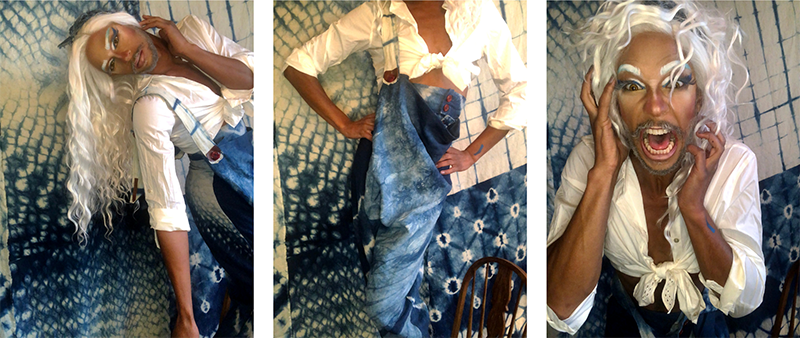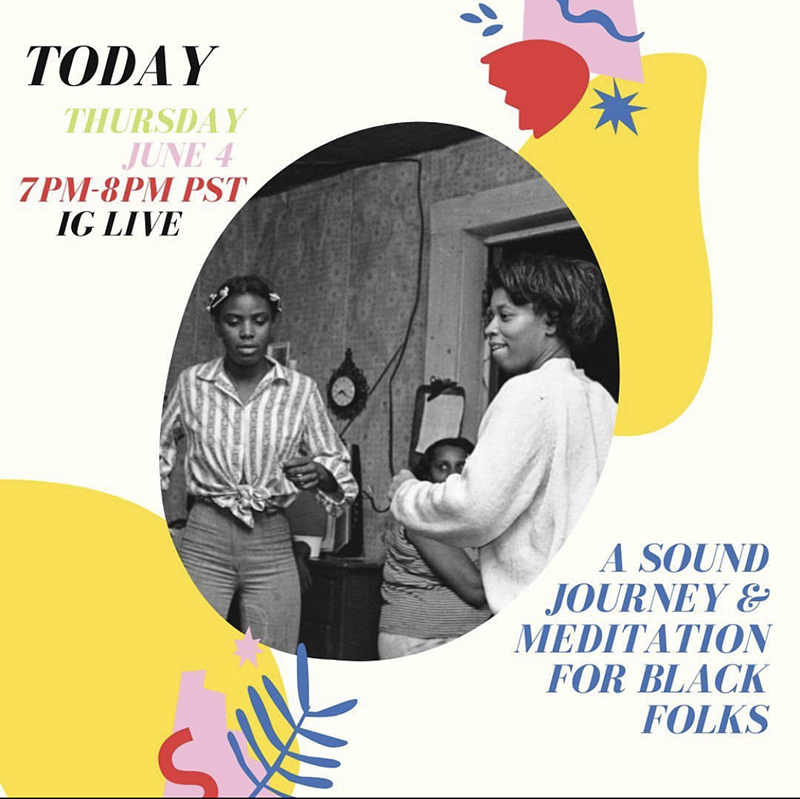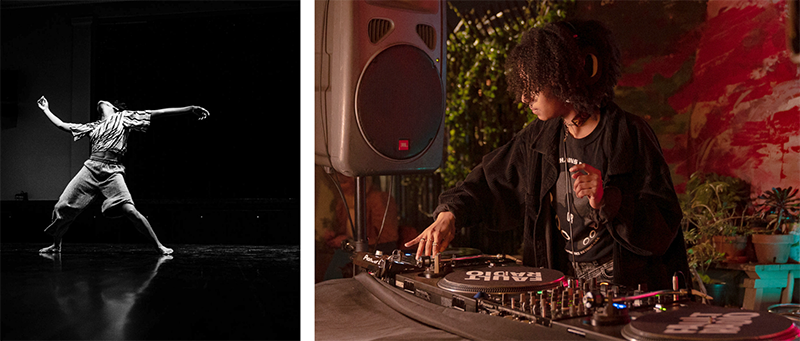Reflections on “Dance for mmm”
BY JHIA JACKSON AND JOCELYN REYES
Over the past year, many of us have found ways to navigate creativity and artistry during a global pandemic, as our traditional ways of gathering were forced to shift. In finding new ways of staying creative and sharing, we reimagined what it meant to be in the realm of dance and performance. How do we carry what we’ve learned and experienced in the past year forward?
We were each Joe Goode Annex Co-Production artists in the San Francisco Bay Area who were supposed to have our own individual, in-person performances in 2020. The pandemic brought a sudden shift in our timeline and uncertainty over whether we would get to use the opportunity at all. A pleasant surprise was the opportunity to collaborate on a virtual conversation series, “Dance for mmm,” which fostered new relationships between artists who didn’t really know each other and led to our own shift in creative skills and products.
In the “Dance for mmm” series, we spoke with a diverse group of multidisciplinary artists who are all active in the world of dance and who shared their experiences navigating the questions and challenges of being an artist during the early days of the COVID-19 pandemic. The shift to virtual engagement, abrupt changes in employment, the ways living/working/creating spaces congealed, and the ability to access resources all had a profound impact on these artists’ creative practices. Through our conversations, we learned about how they moved through these challenges. This led to shifts in artistic discipline, surprising life lessons, and opportunities to reinscribe and revisit previously learned lessons or ideas for innovation. Through reflection on how quickly we had to adapt as our lives were collectively disrupted, we find lessons that will prove invaluable.
~~
First session takeaways: How are identities formed by our environments? (Jes DeVille). Transparency and accountability (Sadie Wilking).
Tools used by artists: Journaling, refocusing attention to the body, and being curious about how they approach practice.
Jes DeVille, an Afro-Latinx choreographer and creative producer (NYC/SF Bay Area) who had been heavily engaged in producing immersive performance experiences and arts administrative work prior to the pandemic, used the newfound space in their life to refocus on their commitment to interdisciplinary performance, somatic ecology, embodied media, and using technology in innovative ways. Though their administrative work continued in a limited capacity, they were able to refocus on their own artistic practice by diving deeper into an exploration of the ways that dancers can connect with each other and their ancestry through nature. They had spent the past five years engaging in land-based practices, and the pandemic allowed them to create and refine their unique movement methodology within this embodied Earth-centered framework. The new project that Jes is developing is called Goodfoot. This innovative programming allows them to share their love and knowledge of arts, tech, and the environment with those who may not otherwise have access to these worlds through classes, performances, and a mobile app.
Sadie Wilking, an LA-based choreographer with experience in film and a current graduate student at the London Contemporary Dance School, used the time to reflect on her childhood experiences in dance training and the hard lessons she was learning as an adult. She combined these to inform how she approaches her work as a dance educator now, including offering her students tools for communication, body awareness, and integrating wellness practices into their technical training. She spoke of the importance of transparency and accountability when working with other artists and learning to take care of yourself and your body in order to give more to your community.
Goodfoot is “A learning lab inviting communities to contemplate physical and environmental wellness through Social Action storytelling adventures.” Jes is currently working on developing a mobile app. Visit their website at www.danceoutdoors.com/ to learn more about their work.
~~
Second session takeaways: Getting past perfectionism, beauty in imperfections, embracing failure (Betty Towers). Translating movement to music and unearthing identity (Stephanie Hewett). Limitations of space and technology leading to fresh movement investigations (Erin Yen).
Tools used by artists: Archiving creative process through photography and film, using technology for a deeper connection with yourself.
Betty Towers is a staple in the Bay Area drag scene and a confidant of many contemporary dance artists. Betty’s strength lies in their ability to make personal connections with a wide variety of people and mesmerize audiences. This commitment to in-person connection often left less time for fashion design and costuming ventures. Rather than turn to virtual performance opportunities, they’ve used the time to engage in the slow, meditative work of natural dye processes and upcycling fashion designs. Sewing, dyeing, and modeling their creations has helped them become less afraid to fail as mistakes and snags are inherently part of the learning process. They’ve valued the opportunity to practice going to places of discomfort, trying new things, and finding beauty in imperfections.

Styling, dye-work, and photography by Betty Towers
Stephanie Hewett is a movement-based interdisciplinary artist (SF/Bay Area) who is celebrated for the nuance and fluidity of their performances. As a queer, Black, Afro-diasporic artist, their work is always already rooted in emancipatory practices. Over this past year, they were drawn to reinvestigate their ancestral identity by using their movement improvisational scores to influence their music creation. Self-reflection, diving into their personal identity, and renegotiating their relationship with movement and sound led to research that now manifests as Madre Guia – a DJ and electronic music producer.
Erin Yen, a San Francisco dancer and choreographer known for their athletic and energetic performances, was not satisfied with Zoom performances. As a performer and audience member, they were dissatisfied with the way virtual space seemed to flatten the work. This led Erin to new explorations of working around the lack of depth and limitations of space, physically and virtually. She began to research how humans interacted with the internet and its related technologies, including the physical mechanisms of attention spans, causing shifts in her movement practice and shaping the way she incorporated film.
Erin Yen’s video entitled “Taking up space: through tech, pandemic, and beyond” shares their physical and recorded exploration of the aforementioned themes.
~~
Third session takeaways: Questions are good – not knowing can be a fruitful part of the creative process. Who do we make art for? Is it possible to make art for just yourself? Both artists agreed it can be difficult to create without an intended audience in mind as ultimately you want to share your work so that audiences are engaged.
Tools used by artists: Practice sound journaling by taking audio recordings of your day or archiving the music that moved you with a note (Rhae Dawn Royal). Play with the technology you already have rather than worrying about the quality of what you don’t have (Miguel Gutierrez).
Miguel Gutierrez is a New York City based choreographer, musician, and educator whose innovative use of sound, language, and identity in their live performances caught our eye. As they shared their thoughts on how the creation and manipulation of sound in all its forms – musical, dissonant, articulations, etc. – are integral to their creative process and subsequent performance, they came to the conclusion that it was ultimately a consideration of the engagement with self and others in their work. For them, it isn’t possible to make art without considering the audience, as they are always thinking about who it is going to be seen by at every step. From grant writing to how they present the work, the presentation of ideas is not separate from the creation of the work, and that has been a motivating factor for continuing to create and feel community during an isolating pandemic.
Rhae Dawn Royal is a musician, singer, and composer based in Oakland who typically made sound for others. Before the pandemic, they were engaged in numerous projects from live dance performances to podcasts to commercials. The social disruption of the pandemic and the increased need for Black Lives Matter activism led to a need for prioritizing their own personal sense of wellbeing. In doing so, they began a daily practice of sound journaling to help them take stock of their rapidly shifting life and feel rooted in a form of expression. This sparked a small series called “Sound Journeys and Meditations,” an installation streamed on Instagram explicitly for the healing and gathering of Black people during the height of the protests. They discovered that their own self-care created a much-needed space for community healing. Moreover, the limitations of their own access to high-quality technology and those of their potential audiences similarly reinvigorated a commitment to investing in and exploring their unique perspective as a musician.

Designed by Rhae Dawn Royal, image from Black Archives
~~
Jocelyn and Jhia’s main takeaways: Limitations are a form of possibility. Experimenting in new creative practices can facilitate new personal and professional relationships. Be flexible with your timeline, clear about expectations, and don’t be afraid to assert your needs when it comes to your work.
Tools used by artists: Google calendar, Google drive, or a similarly easy way to create shareable notes. Maintaining an address book with at least two modes of contact per person is surprisingly old school but incredibly necessary. Keep records of communication to help with efficiency and accountability.
This series was an opportunity for us to lean into our shared passion for celebrating other artists and learning more about the intention and process behind their works. We each proposed artists whose work inspired us, selected a sample that was already available through their social media or website, and summarized what specific aspects of their work we found intriguing. Then we reviewed each other’s options, selected ones that piqued our curiosity or seemed to relate to one of the inspirational artists we had proposed, and invited them to participate in a one hour conversation about what they were currently working on. The interested artists were then organized across the three events according to similar themes we saw in their work, such as a commitment to transformative education, critiquing what “live” performance meant during a pandemic, or investigating the relationship between sound and movement. We helped prepare them for the experience by offering to discuss their ideas with them and then facilitated their participation in the event by having a few questions prepared that were applicable to all the artists, as well as some specific to the artists who were in conversation with each other.
The opportunity to collaborate on a project together that required new skills for both of us created a space for interpersonal connection and creative problem-solving. It felt like we were coming from a mutual space of curiosity and humility as we discovered how our skills and experiences as performers, choreographers, and educators translated into a completely new endeavor. Similar to the artists we spoke with, we found a lot of value in taking what felt like a big risk, being vulnerable, and finding out that our voices and ideas were really wanted, valued, and needed. The opportunity to practice publicly speaking to others about all aspects of artistic life was invaluable for our professional development and our personal sense of well-being. As dancers, we often have limited opportunities to discuss our finished works and rarely get to drive conversations in a public setting. In creating a space to hear other performers and artmakers casually share what was on their mind, we inadvertently created the same much-needed space for ourselves.
After reflecting on the series as a whole, our main lesson was that artists are adaptable, malleable, and resilient. No matter how difficult a situation may be, we find ways of creating work. By finding lightness within the mess and the chaos of our environment, by leaning into what brings us joy and interests us the most, we have a bountiful reserve of resources for creativity. If we rethink what it means to be productive, what is required to meet the threshold of a “professional, working artist,” and investigate what our own personal standards of artistry are, then it doesn’t matter how much we produce in comparison to others. If we feel it, we need it, and we make it, then it will resonate with someone else as well.

Left photo of Stephanie Hewett by Robbie Sweeny (@robbiesweeny), Right photo of Stephanie Hewett by B. Dukes (@bdukesthetruth)
~~
Jhia Jackson and Jocelyn Reyes are investigating creating more spaces for interdisciplinary creativity check-ins in the future, while continuing to deepen their newfound friendship and professional relationship. Jocelyn Reyes is a choreographer, performer, and teaching artist based in San Francisco with ties to LA. Jhia Jackson is a movement-based artist and scholar, as well as the cofounder of Emerging Black Bay Artists and is currently based in San Francisco with ongoing projects in LA, NYC, Maine, and Maryland.
